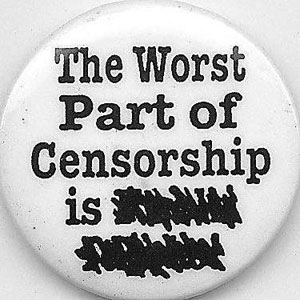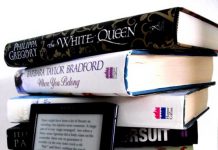 I haven’t been posting a lot, lately—partly because it takes so much longer to write an article by speech than it does by typing it, and partly because I seem to be sleeping a lot more lately. This broken arm is sapping a lot of my energy. I will be having an operation next Tuesday to put a plate and screw in, and after I recover from that I should be somewhat more active.
I haven’t been posting a lot, lately—partly because it takes so much longer to write an article by speech than it does by typing it, and partly because I seem to be sleeping a lot more lately. This broken arm is sapping a lot of my energy. I will be having an operation next Tuesday to put a plate and screw in, and after I recover from that I should be somewhat more active.
With that in mind, when I do post something, it’s either going to be something that I can write very quickly, or something that I care enough about to spend the time and energy on—and this is one of the latter cases.
When I was catching up on my RSS feeds today, I became aware of an article that concerned columnist Meghan Cox Gurdon posted in the Wall Street Journal, about how children’s literature these days is full of nasty stuff that parents wouldn’t want their kids reading about:
Pathologies that went undescribed in print 40 years ago, that were still only sparingly outlined a generation ago, are now spelled out in stomach-clenching detail. Profanity that would get a song or movie branded with a parental warning is, in young-adult novels, so commonplace that most reviewers do not even remark upon it.
As might reasonably be expected, the article has proven controversial, and is drawing a lot of discussion on Twitter under the #yasaves hashtag. It first came to my attention through a rebuttal in the Guardian books blog, but I came across a longer response on Diane Duane’s blog. This post is excellent and I highly recommend going to read it yourself, but she makes two major points:
First, from her professional background as a psychological nurse, she points out that Gurdon’s assumption that "books focusing on pathologies help normalize them" and might promote behaviors such as self-harming is unfounded in reality—and, indeed, young people who have problems are often helped by discovering that they are not alone, and being able to read about others who experience and deal with the same sorts of issues.
Second, she makes a more pragmatic observation that, in today’s technologically-advanced world, where kids actually know more about how to work new technologies than their parents, any measure a parent might take to try to prevent his or her kids from reading unwanted material can be circumvented with extreme ease.
I remember when I was a kid, and visiting my grandparents in Columbia, Missouri, I somehow got ahold of one of the John Gardner James Bond novels, Icebreaker. I was couple of chapters into it, and enjoying it immensely, when my grandparents took it away from me, having determined that it was not the sort of book a person my age should be reading. (Granted, that’s not exactly a children’s book, but I had already been reading adult books that had worse stuff happen in them; James Bond really wasn’t all that outré as far as I was concerned.)
This quite annoyed me at the time, but the era being what it was, I didn’t really have much of a way around it. I suppose I could have seen if I could find the book at the local public library, and I’m not really sure why I didn’t bother back then. But at this point, if I were at the same page in a similar situation, all I would have to do is go to BitTorrent and I’m sure it would be right there.
Indeed, after generations of parenting, anybody should know by now that forbidding kids to read a particular book is all the more likely to make them seek it out. And just as it’s an axiom of military command never to give an order that you know will not be obeyed, people should realize that the same thing would b toe true of parenting.
It’s not as if controversy over children’s literature was even anything new—a hundred years ago, the same controversy arose over Mark Twain’s classic novels, Tom Sawyer and Huckleberry Finn. Even as recently as this year, people were still finding their use of the N-word controversial. UPDATE: On the same note, a friend pointed out this essay by G.K. Chesterton entitled “A Defence of Penny Dreadfuls”.
Duane suggests that parents should use this as an opportunity to read books along with their kids and discuss them—turning it into a shared experience that will be a memory that both the parents and the kids will treasure in years to come. I would add to this that, in this era of decreasing literacy, when publishers are worrying about their very future, I would think that parents ought to be glad their kids are finding books they want to read it all.
































Sigh, I see you’re helping to perpetuate the misunderstanding of Gurdon’s article. I’ve been pointing out how people have been missing her point for the last two days, so I’m calling it quits on that.
And you know, kids have been finding ways around the rules parents make to keep them from smoking & drinking & doing drugs, so I guess we should just do all those things along with the kids to help them understand it better.
I have to disagree. What’s in these books, both YA and adult, is depraved, graphic, sex and violence. My high school aged kids hated reading it in school and avoid it like the plague in their private reading.
We’re not talking about realistic war violence, we’re talking about perverted sexual torture, multiple rapes, etc. The Girl with the Dragon Tatoo and The Hunger Games are good examples.
No one needs to be exposed to this garbage, especially children.
Just FYI for the comment above: The Girl with the Dragon Tattoo is NOT a children’s or young adult book. I’m sure there are plenty of actual relevant examples you could have chosen; the fact that you did not makes it sound as though you have no idea what you’re talking about.
I’ve got to say that my mother was very liberal in letting me read whatever I wanted to read. I would raid her bookshelves starting at the age of 10 and the first ‘adult’ book I read was ‘Salem’s Lot and this was back in 1978. She didn’t care what I was reading as long as I was reading, that’s what was most important in her eyes. As far as Tom Sawyer and Huck Finn went, I read that at 8 and I wasn’t scarred by it. When it came to the N word my mother explained what it meant and the context of the time it was written.
Kids now are exposed to more things now then when I was growing up. The internet is kids and teenagers way of getting info faster and easier on a much wider range of topics. I think that if you censor a child ( there has to be some censorship depending on age and reading maturity) too much they will seek out what is forbidden. When they do get their hands on books that are too much for them in either a sexual or violent content they will stop reading that book.
I think that reading should be encouraged and that parents should be happy that kids want to read at all in an age of internet, social networking sites and video games….. We all know how violent and graphic they are but boys love violent and bloody video games but much isn’t said about that is there? But violences in books is, what is the difference?
It sounds like Common Sense’s kids are practicing their own book selection. I am a K-12 librarian and I do have some edgy books in my YA collection. I don’t make them available to kids under seventh grade, and I do draw the line. I admit I wouldn’t be comfortable for my grand kids to read some of them, but I count on their parents to provide guidance for them. I don’t buy everything that’s out there.